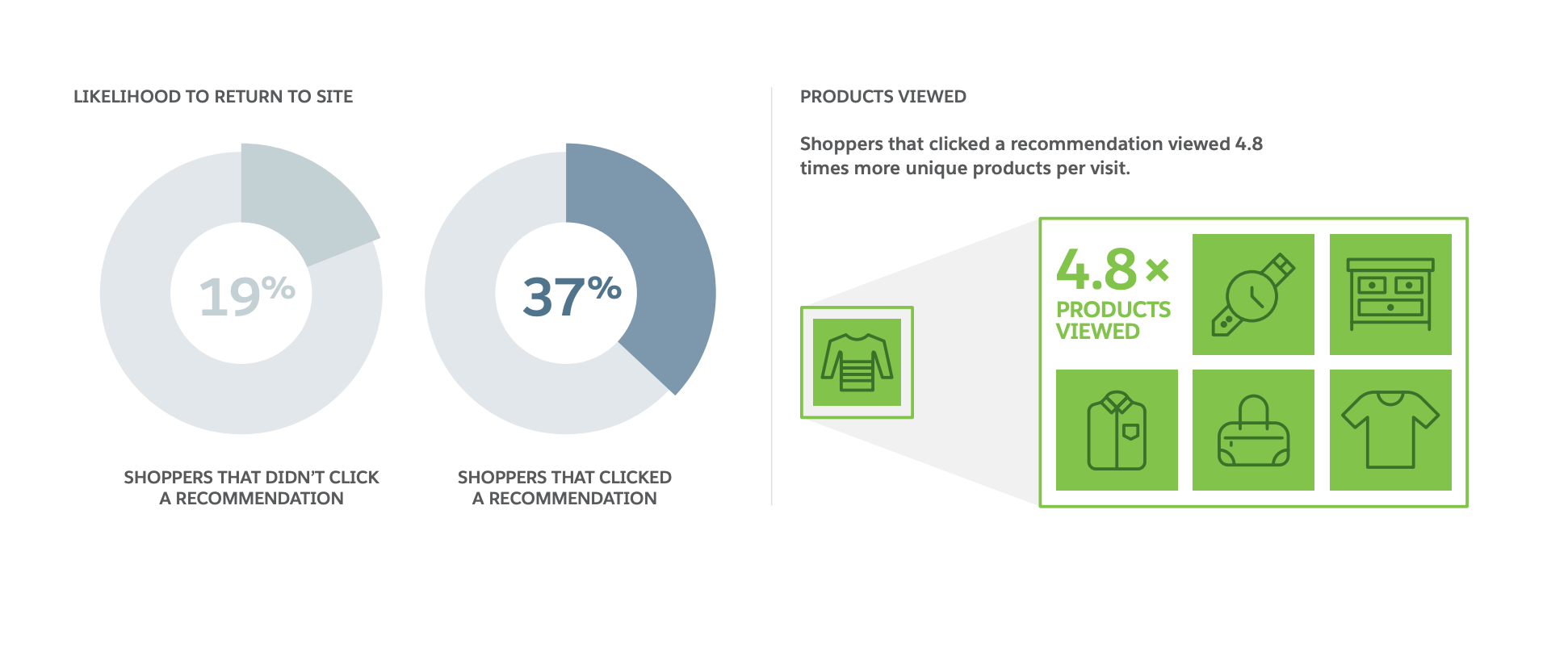Whether you know it or not, you’ve experienced the power of product recommendation engines. This happens when shopping online and sites like Amazon show their customers other items “they might also like.” You get emails or texts from brands promoting similar products with personalised promotion codes to encourage your purchase on social media platforms too!
In this blog post, we will explore the world of AI product recommendations and discuss how they can influence consumer decisions. We will also look at some experimental research on the subject to understand how it helps increase online sales for SME webshop owners. No matter the traffic volume of your online store.
What is an AI product recommendation?
From the perspective of a web shop’s owner, a product recommendation is a tool to upsell and cross-sell in an online store. The engine shows similar products with more valuable prices or shows complementary goods for your online shoppers.
For example, if you’re looking at purchasing a new laptop on Amazon, the site might also recommend things like a similar laptop, or complementary products like screen protection, carrying case, and wireless mouse. In short, product recommendations are a filtering system that seeks to predict and show the items that a user would like to purchase. These days product recommendation has become more sophisticated with the help of artificial intelligence (AI). Product recommendation engines use AI algorithms to sift through data and find patterns that indicate what users might want.
The algorithm looks at factors like what users have purchased in the past, product ratings and reviews, items that are frequently bought together, and even the time of day or year when a product is typically purchased. By understanding these patterns, product recommendation engines can make better predictions about what users might want in the future and show them more relevant recommendations.
How do AI product recommendation tools work ?
To better understand how product recommendation tools work, let’s take a look at how Amazon’s product recommendations work. Amazon has one of the most well-known and successful product recommendation engines out there.
The engine looks at factors like past purchases, product ratings and reviews, items that are frequently bought together, and even the time of day or year when a product is typically purchased. By understanding these patterns, product recommendation engines can make better predictions about what users might want in the future and show them more relevant recommendations.
Amazon gets about 35% of its revenue from recommending products to customers. Netflix saves $1 billion a year by recommending content that keeps customers engaged, and they are able to confidently spend $6 billion a year on their own content.
If these numbers haven’t convinced you yet, let’s look at some experiments to see the impact.
Experiment proves the impact of product recommendation tool
2021 Upsy launched an experiment on an online mobile webshop -Suojakalvo to test whether Upsy’s product recommendation tool affects buying decisions and revenue. The test was conducted in 10,000 sessions. In short, 1 session is 1 time a customer visits the website.
Half of the ten thousand sessions visited the website without Upsy’s recommendation. The other half visited the website with the product recommendation from Upsy. It was found that visitors who used product recommendation tools were more likely to make a purchase. The conversion rate and revenue increased significantly. Suojakalvo gets 50cents more sales for each visitor and is selling 70 000€ more in a month with recommendations compared not to have them.
This aligns with the fact that 35% of Amazon revenue comes from their product recommendation engine. Read more about Upsy ‘s experiment.
Examine the psychological effects of product recommendations
1.Serves as a resource for online shoppers
It is a scientific prove, when online shoppers are prone to a large amount of product information online, they have no option but to filter and omit information. If an e-store installs a product recommendation tool, visitors will count on it as a way to save their cognitive effort for making decisions or to find similar products to compare. Also your chance of getting visitors to engage with your reference increases if you provide product options quickly.
2.Decision Time
AI product recommendations increase impulse buying on your online store. By providing visitors with an easy way to find more options, you can encourage them to make more spontaneous purchases.
This tech also enables your visitors to discover more options that they may not have otherwise considered. As a result, they can find what they want faster and without having to look for information themselves. Ultimately, product recommendation tools can help you increase sales and grow your business.
3.Extent search process
People who click on recommendations find what they are looking for more quickly than people who don’t. But this doesn’t mean that they leave the site right away.
In fact, from Saleforce study, people who click on recommendations stay on the site for an average of 12.9 minutes. This is much longer than the 2.9 minutes that people spend on the site when they don’t click on any recommendations. This means that they are more interested in the site and are likely to come back.
In the same study from Salesforce 37% of people who clicked on a recommendation during their first visit came back, compared to 19% for those who didn’t click on a recommendation during their first visit.

4.Increase engagement and conversion rate
From Sciencedirect, the consumer decision making process is the trade off between the accuracy of their decision and how much effort they put in.
If web visitors want to make more accurate decisions, they need to spend more time and effort. It is often difficult to balance these two objectives. An AI recommendation tool, however, helps reduce the amount of work an individual needs to do to find the right choice. Thus it leaves shoppers more time to make a decision.
Researchers at Salesforce found that shoppers who clicked recommendations created shopping carts 4.5 times more often than those who didn’t. In many cases, these shoppers convert at a higher rate after clicking a few recommendations and filling up their carts. There was a 4.5-fold increase in conversion rates for site visits including product recommendations.
5 common types of product recommendation engines
From Recommender Systems Handbook, here are five common types of product recommendation engines:
1.Collaborative filtering
The collaborative recommendation approach means “people-to-people correlation”. In the simplest and original implementation, it recommends items that were liked by other customers with similar tastes. This is done by comparing the rating history of different consumers to sort customers into groups, and then calculating the similarity in taste of two users.
For example, if customer A has purchased hat, sun cream, glasses, and swimming goggles, and customer B has also purchased hat, sun cream and glasses, then the RSs would consider that customers A and B share the same preferences. Therefore, the collaborative recommendation RSs would recommend customer B to buy swimming goggles.
2.Content-based recommendations:
This approach relies on calculating the object-user similarity. For example, if the target customer has positively rated a song that belongs to the same genre as other songs, the system will recommend the target song to that customer.
3.Demographic recommendation
The demographic recommendation approach recommends products based on the customer’s profile. This means that the approach looks at a customer’s age, sex, nationality, location, and career in order to find similarities between them and other customers. This is often done by looking at what websites customers from the same country and who speak the same language are directed to.
4.Knowledge -base recommendations
This approach relies on explicit knowledge about the item assortment, user preferences, and recommendation criteria. By taking all of this information into account, knowledge-base recommenders are able to provide more accurate and tailored recommendations.
5.Hybrid recommendations
Hybrid recommendations are a great way to get the best of both worlds. This approach combines different variants on recommendation systems, thus enabling you with an intuitive and personalised experience while eliminating their disadvantages – especially when it comes down to how accurate they can be!
Summary
In Netflix, the moment you first log in to your accounts, what you see is fully personalised to your tastes. From there Netflix hopes you will discover your new favorite show or film.
It is the same in your webshop, the moment a visitor first lands on your website, you should present them with products that are tailored to their individual tastes. This will encourage them to discover new and exciting products that they may enjoy.
It is also important to note that, normally, only 1-2% of visitors will end up becoming buyers. However, with the help of an AI-based product recommendation system, you can increase this number to up to 10%. If you’re looking for a way to boost your sales, or simply want to offer a better experience for your customers, you should consider using AI product recommendation tools.
We know they can be daunting, but our team is here to help walk you through the process and make sure you get the most out of these powerful tools. Talk to us today about how we can help set up and implement an AI product recommendation tool that will have a real impact on your business.
